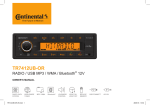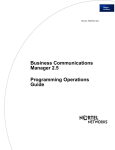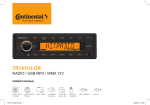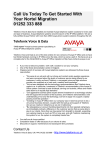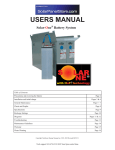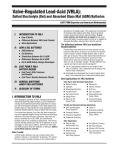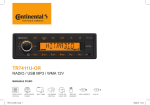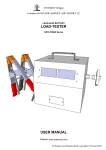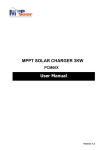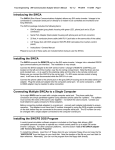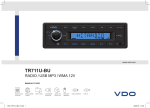Download battery charging guidelines for 6 volt deep cycle batteries
Transcript
BATTERY CHARGING GUIDELINES FOR 6-VOLT DEEP CYCLE BATTERIES Introduction – Your 6-volt deep cycle battery set has been specially formulated for long cycle life and has particular voltage and specific gravity characteristics. The battery charging set points specified in this guide are for these batteries only, and should not be assumed appropriate for other batteries. It is far easier to discharge a battery than to recharge it. Both the charge and discharge of batteries involve significant inefficiencies. As a rule of thumb for each amp hour of power taken out of a battery 1.5 amp hours must be replaced. In order to complete the chemical process, which recharges a battery the electrolyte, must reach 104°F. The method used to ‘heat up’ the electrolyte is the application of charging current (amps) to a discharged battery. If insufficient charge is applied to bring the electrolyte to this temperature the batteries will never fully recharge, and over time, their capacity will be reduced. Minimum Charging Requirements –The ideal charging current, which would be applied to recharge your battery, is 10% of the 20 hour rated capacity of the battery. For example a 220 Amp hour battery (220 Amp hour @ 20 hour rate) will require an initial start up rate of 22 amps to be supplied by the selected battery charger. A combination of charging sources such as generator/PV array can be used to achieve the initial charge. In general, you need a larger generator than you might think you do to charge these batteries. Voltage and Time Settings – In addition to minimum charge rates there are charging voltage settings, which are specific to your 6-volt deep cycle battery bank. ‘Bulk’ Charge Voltage is the voltage at which the batteries will receive most of the charging. When the battery has reached its bulk voltage level the charge current will slowly decrease as batteries become more charged. As a battery becomes more charged it presents more resistance to the flow of current than when discharged, hence the rate of amps declines during a charging cycle. This part of the charging cycle is called the ‘absorption’ stage. We recommend 30 minutes of absorption time per 100 amp hours of battery bank rated capacity (20 hour rate). All batteries will self-discharge over time, even if they are not used. In stand-by applications where utility power is available batteries are often finish charged at ‘float’ voltage. This is the voltage level, which can be applied to the batteries to maintain their charged state and, at the same time, minimize loss of electrolyte. In generator cycle charging applications it is rare to “float” the batteries as it represents a costly and inefficient use of fuel. Regular ‘equalization’ charging is required as part of a battery maintenance routine. Daily battery drain down will require a monthly equalization for optimal performance. An equalization charge is an intentional overcharge, which causes rapid bubbling of the electrolyte, which in turn helps dislodge sulfation, which occurs naturally during normal charge/discharge cycling. Equalization charge settings involve both voltage and time specifications. An equalization charge should last at least 2 hours or the same as the absorption time; whichever is larger. Many programmable chargers and inverter/chargers have provisions for custom voltage, current, and time settings. The table below shows the appropriate voltage settings for Bulk, Float and Equalization stages of charging. Per Cell 12 Volt 24 Volt 48 Volt Bulk 7.2 14.4 28.8 57.6 Float 6.6 13.2 26.4 52.8 Equalization 7.8 x 2 hours 15.6 x 2 hours 31.2 x 2 hours 62.4 x 2 hours EA Energy Alternatives Ltd • 5 – 4217 Glanford Ave • Victoria • BC • V8Z 4B9 Toll free: 1 800 265 8898 • Local: (250) 727-0522 • Fax: (250) 727-2286 [email protected] www.EnergyAlternatives.ca Page 2 of 4 Specific Gravity - The specific gravity of your 6-volt deep cycle battery is another method to check the status of your batteries. Take readings every ½ hour during the last part of Absorption Stage, when the hydrometer does not rise from your last reading the batteries are fully charged. The correct fully charged specific gravity of your 6-volt deep cycle battery is: 1.265 (will vary dependent on battery age, condition and ambient temperature) Battery life is directly related to keeping your batteries fully charged. Batteries are more resistant to degradation and freezing when they are fully charged. Configuring a DR Series Inverter for 6V Deep Cycle Batteries: For normal operation, the battery type selector should be set to # 1 – Deep cycle lead acid. For an Equalize charge, set the battery type selector to Equalize. We highly recommend the use of Battery Temperature Sensors (BTS), which is an option for DR inverters and C-series controllers, included with SW series inverter. This sensor will allow the controller to automatically compensate charge rate according to the temperature of the battery. Colder batteries require significantly higher charge rates. The BTS should be mounted such that it will give an accurate reading of the battery temperature, wedged between 2 batteries below the fluid level of the batteries. Programming a SW or PS Series Inverter for 6V Deep Cycle Batteries: The SW inverter is configured through the digital menu or on the SWRC remote panel or laptop via SWCA interface. Instructions below assume familiarity with the operation of this inverter. More detailed instructions are available in the user manual. The factory default settings on the SW inverter are not adequate for charging 6V Lead Acid Batteries. If the unit is disconnected from the batteries it will lose all settings & revert to factory defaults. The new SW Plus inverter will retain settings. The factory EQ setting is not high enough to equalize the batteries, for the best performance, configure your system as per the guidelines below. Each installation may have it’s own variables and thus these are a general guideline only: Menu 10 – Battery charging: 12 Volt System 24 Volt System 48 Volt System Set Bulk Volts DC 14.4 28.8 57.6 Set Absorption Time 2 – 9 hours depending on capacity of battery bank (Generally 4 hours) Set Float Volts DC 13.2 26.4 52.8 Set EQ Volts DC 15.6 31.2 62.4 2 – 4.5 hours depending on capacity of battery bank Set EQ time (Generally 2 hours) EA Energy Alternatives Ltd • 5 – 4217 Glanford Ave • Victoria • BC • V8Z 4B9 Toll free: 1 800 265 8898 • Local: (250) 727-0522 • Fax: (250) 727-2286 [email protected] www.EnergyAlternatives.ca Page 3 of 4 Programming a C-series (C35/C40/C60) Controller for 6V Deep Cycle Batteries: The C-series controllers unfortunately do not offer the ideal adjustments for some settings. We generally don’t recommend that the automatic-EQ feature be used; as it’s unlikely you will achieve a proper equalization charge. Instead, control this manually by depressing the reset switch for 10 seconds. Unattended sites are an exception where using the automatic EQ feature can be beneficial. Equalization setting on a C-series controller allows the voltage to rise 1 Volt above the set bulk voltage, adequate for equalization of 12 Volt systems but in 24 or 48 volt systems not a true equalization charge. The following settings are made via the adjustments accessed by removing the front cover of the C-series controller. The manual describes this process in detail. A digital voltmeter is required to properly calibrate these settings. The values for the bulk and float settings can be found on the previous page. How to Equalize 6V Deep Cycle Batteries: Goggles, rubber gloves and a long narrow funnel are recommended for battery equalization. Have baking soda on hand to neutralize any spills on ground, clothes, etc. Do not allow baking soda inside the batteries! Bring batteries to a full normal charge. Test with Hydrometer & record all cells. Ensure electrolyte levels are proper (you will add more during the charge cycle). Initiate an equalization charge according to your inverter type. During the final hour of equalize charge, make sure you top up the electrolyte with clean, distilled water. Ensure no debris enters into the battery! Make sure the funnel is clean before using it! Battery tops should always be very clean – moisture and debris on the top can cause the batteries to self-discharge. Exercise extreme caution during this process. After the EQ charge, the tops of the batteries will likely have some mist on them. Wipe carefully with a disposable cloth. Keep this away from clothes, etc. Acid on clothes does not necessarily show immediately – next morning or next week you realize the problem and by then it’s too late. Dispose of cloths properly. If batteries have not been equalized for a long time, or have been severely discharged and left in a state of discharge for an extended period, it may take several attempts to achieve a proper equalization charge. Repeat this process daily until you are achieving proper EQ voltage. EA Energy Alternatives Ltd • 5 – 4217 Glanford Ave • Victoria • BC • V8Z 4B9 Toll free: 1 800 265 8898 • Local: (250) 727-0522 • Fax: (250) 727-2286 [email protected] www.EnergyAlternatives.ca Page 4 of 4 BATTERY SAFETY INFORMATION • In the event of exposure to battery electrolyte, wash the area with soap and water. If acid enters the eyes, flood them with running cold water for at least 15 minutes and get immediate medical attention. • • Always wear eye protection, such as safety glasses, when working with batteries Remove all loose jewellery before working with batteries. • Never work alone. Have someone assist you with the installation to be close enough to come to your aid when working with batteries. • Always use proper lifting techniques when handling batteries. • Always use identical types of batteries. Battery life will be compromised when mixing different types or ages of batteries. • Batteries are temperature sensitive. For optimum performance, they should be installed in a stable temperature environment. Battery capacity can be reduced substantially when batteries are cold. • Batteries should be installed in a well-vented area to prevent the possible build up of explosive gasses. For safety reasons, a well-sealed battery box, vented at its highest point to the outside, is required for indoor installation (and recommended for outdoor installation) of your lead acid batteries. Seal entry point of battery cables from inverter into battery box with silicon or duct seal putty. • NEVER smoke in the vicinity of a battery or generator. • Always verify proper voltage and polarity before connecting batteries. • Always connect batteries first then connect the cables to the inverter or controller. This will greatly reduce the chance of spark in the vicinity of the batteries. • Use insulated tools when working with batteries • Do not short circuit battery cables. Fire or explosion can occur. • Always recycle old batteries. Contact your local recycling centre for proper disposal information. EA Energy Alternatives Ltd • 5 – 4217 Glanford Ave • Victoria • BC • V8Z 4B9 Toll free: 1 800 265 8898 • Local: (250) 727-0522 • Fax: (250) 727-2286 [email protected] www.EnergyAlternatives.ca Battery 1 Battery 2 Battery 3 Battery 4 Cell 1 Cell 2 Cell 3 Cell 1 Cell 2 Cell 3 Cell 1 Cell 2 Cell 3 Cell 1 Cell 2 Cell 3 Recharge your batteries often! Clean acid spills with baking soda and water! Use only distilled water to refill your batteries! Always wear gloves and goggles when performing battery maintenance! Cell Voltage Battery 4 Battery 3 Battery 2 Specific Gravity Battery 1 Date Last Equalization Charge Battery Resting Voltage Battery Service Record Chart





